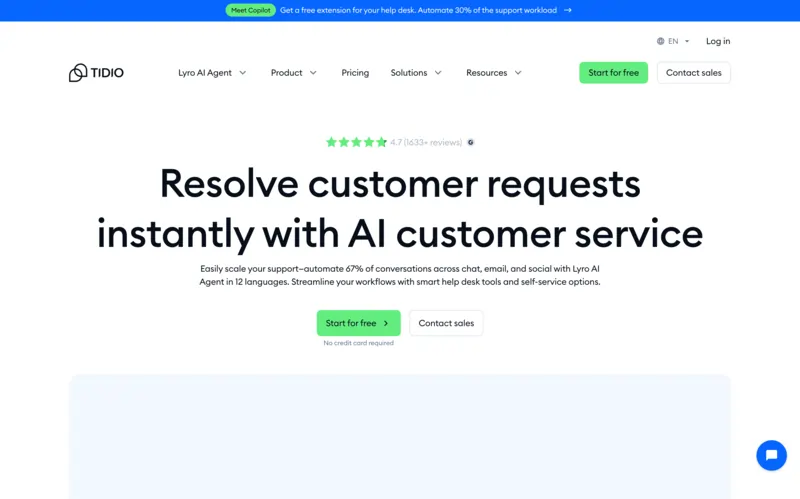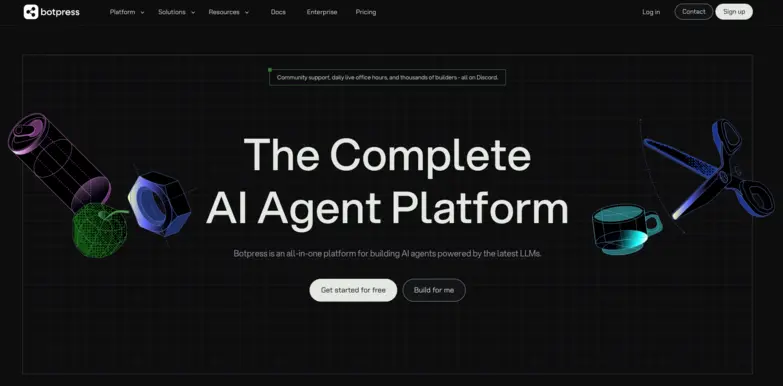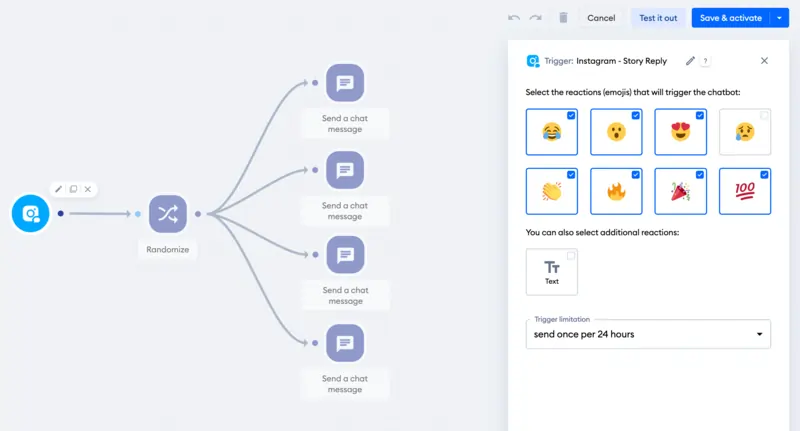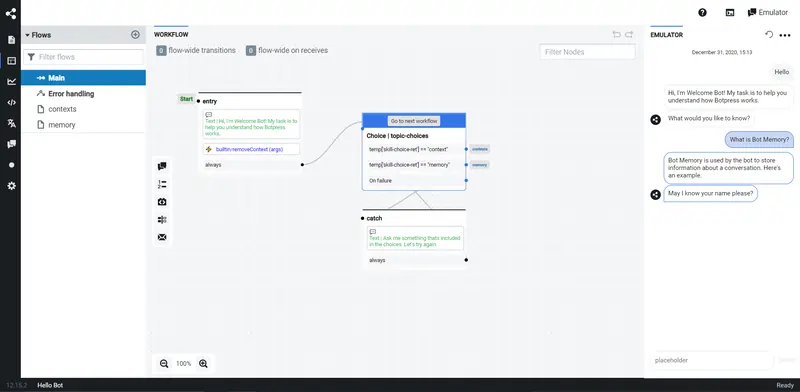Maybe you’re dreaming up an AI chatbot who can juggle live customer chats like a seasoned barista during the morning rush or an AI agent who untangles complex workflows faster than an expert puzzle-solver.
But with so many tools vying for your attention, how do you pick the one that actually fits your business?
Enter Botpress and Tidio. Both are popular platforms for building AI chatbots, each with their own superpowers and quirks.
Wondering which one fits your stack? Dive into our comparison of Tidio and Botpress.
Quick Overview: Tidio vs. Botpress
To summarize, Tidio focuses on helping businesses deploy customer service through AI, whether that’s through a help desk, live chats, chatbots, or AI agents. Botpress is engineered for building AI agents that can handle complex, multi-step workflows – including, but not limited to, customer service.
Think of it this way – if teams need a customer service chatbot that answers common questions and routes chats to human agents, Tidio does this well.
If teams want a more advanced customer service solution – like an AI customer service agent that can solve technical problems, look up information from Salesforce, handle complex conversations, or connect with their CRM, then Botpress is the ideal solution.
Key Features of Tidio
- Live chat for real-time conversations with website visitors
- Lyro AI Agent to automate replies to common customer questions
- Automation flows for creating custom workflows that guide customer interactions
- Library of pre-written answers for frequently asked questions
- Real-time visitor tracking to monitor who’s browsing websites
- Built-in analytics and reporting to measure performance and insights

Key Features of Botpress
- Visual flow builder for designing complex conversations and workflows
- Unlimited integration options to connect with APIs, databases, and third-party tools
- Persistent memory to retain user context and conversation history across sessions
- Support for custom code execution for advanced logic and custom functionalities
- Choice of any large language model (LLM) for powering AI responses
- Role-based access control (RBAC) and enterprise-grade security features
- Built-in analytics and monitoring tools for tracking bot performance
- Active developer community and resources like Botpress Academy for support

Feature-by-feature comparison
Tidio vs. Botpress Pricing Comparison
Tidio Pricing
Tidio offers a free plan that comes with 50 billable conversations.
Tidio also provides several paid plans:
Botpress Pricing
Botpress provides a free plan that comes with a $5 monthly AI credit. An AI Credit in Botpress is like a monthly budget to power the smart features in user bots. Everything from knowledge retrieval to rewriting text uses these credits.
In terms of paid plans, Botpress offers a few:
Integration Capabilities
Both Botpress and Tidio offer pre-built integrations, so AI chatbots built with either of these platforms can connect to other systems in a workflow.
Tidio offers 37+ pre-built integrations, making it easy to connect with popular tools like Shopify, WordPress, and Mailchimp.
For example, Tidio users can quickly link their chatbot to Shopify for order status updates or use Mailchimp to follow up with chat leads via email campaigns.
Botpress offers 190+ pre-built integrations and also provides flexible connectors for building custom integrations.
Businesses using Botpress can integrate with platforms like Salesforce, HubSpot, and Zendesk to verify customer account details via API calls, update CRM records, or trigger complex workflows that span multiple systems.
TL;DR: Tidio is a good fit if users want pre-built connections to popular marketing tools like Shopify for tasks such as order updates or marketing follow-ups. Botpress is a better choice if users need integrations with enterprise systems like Salesforce, HubSpot, or Zendesk, or if users want to build custom API connections and automate workflows across multiple platforms.
Use Cases
Whereas Tidio focuses only on customer service, Botpress is versatile enough to support any business application.
Tidio’s core strengths revolve around customer service and lead capture. It’s designed for handling live chat and automating replies to common questions.
Businesses often choose Tidio when they want a simple solution for supporting customers and following up on new leads without much complexity.
Botpress, while also capable of handling customer service, is built for a wider range of tasks across different functions.
For example, Botpress can help with sales automation, qualifying leads by asking follow-up questions, scoring prospects, and integrating with tools like Salesforce to book meetings or move deals forward.
TL;DR: Tidio is a solid choice if user focus is on customer service and basic lead capture, and users want a chatbot that’s simple to set up and manage. Botpress is the better fit if users are starting with customer service but also want the option to scale their chatbot to handle more complex tasks or connect with other systems like CRMs.
Security Features
Both Tidio and Botpress include essential security measures, but there are important differences in the level of security offered.
Tidio focuses on small to medium-sized businesses looking for simple customer service chatbots. Because it’s designed for less complex use cases and typically handles less sensitive data, Tidio offers fewer advanced security and compliance features.
Botpress is built to support larger enterprises and more varied use cases, including workflows that may involve sensitive or regulated data. As a result, Botpress provides a broader range of advanced security features and compliance options.
Here’s how the two platforms compare:
Data Training
TL;DR: Tidio is well-suited for businesses looking to quickly set up chatbots using FAQs and predefined responses. Botpress is a good choice for teams that want more flexibility in how data is integrated and used to build more tailored conversational experiences.
Tidio provides features like uploading FAQs, creating knowledge bases, and setting up canned responses. Users can manually enter common questions and answers or upload documents that the bot can reference.
Botpress also lets users upload documents and create knowledge sources but adds additional options such as connecting APIs to pull in live data. It supports handling various data formats, including structured tables, JSON files, and unstructured text. Botpress offers tools for training chatbots to manage conversations that involve context switching, follow-up questions, and more detailed business logic.
Customization & Flexibility
TL;DR: Tidio is a good fit if teams want to build chatbots quickly with no-code tools and predefined features. Botpress is the better choice if teams need a platform that supports both no-code and custom coding for complex use cases.
Custom logic and coding is one of the biggest differences between Tidio and Botpress.
Tidio focuses on ease of use and prioritizes no-code solutions. Users can create conversation flows with a simple drag-and-drop builder and use prebuilt triggers to manage chatbot behavior. However, Tidio does not support adding custom code or building advanced logic beyond what its visual tools provide.

Botpress also offers a visual flow builder, allowing non-developers to design chatbots without writing code. In addition, Botpress gives developers the ability to add custom code in JavaScript or TypeScript, call external APIs, run scripts, and create more advanced logic and integrations. This makes Botpress adaptable for both no-code users and those wanting full coding flexibility.

Community & Support
TL;DR: Tidio is a good choice if teams prefer a straightforward support system with direct help via live chat and email, and users are comfortable relying on documentation for self-service. Botpress is better suited for users who want access to more interactive learning resources and personalized support for larger deployments.
Tidio provides users with a knowledge base, documentation, and access to a responsive support team. Paid plans include live chat and email support for direct assistance when issues arise. Tidio’s community is smaller but many users can resolve problems independently using the help center and guided tutorials.
Botpress maintains an active Discord community of 30,000+ members, where users can get real-time help and discuss solutions with fellow developers. Botpress also runs daily Ask Me Anything sessions. Beyond community channels, Botpress offers a YouTube channel with tutorials and Botpress Academy, which provides structured courses. For those on Team and Enterprise plans, Botpress has a Customer Success team that offers personalized support.
Which platform is better for my business?
The Customer Service Scenario
Key problem: Managing high volumes of repetitive customer queries
Sarah runs support for a fast-growing e-commerce brand. Her team is overwhelmed by customers asking the same questions every day like shipping times and return policies. She needs to reduce response times and free up her human agents for more complex issues.
- A chatbot that can answer frequently asked questions accurately
- Smooth handoff to live chat agents when needed
- Fast setup without heavy technical resources
Both Tidio and Botpress can help Sarah manage repetitive customer queries and improve her team’s efficiency.
Tidio makes it easy to set up chatbots that answer FAQs and smoothly transfer conversations to live agents when needed. Its user-friendly tools and fast setup are well-suited for businesses that want to lower response times without technical resources.
Botpress also covers FAQ handling and live agent escalation but offers additional options for businesses that want to integrate customer support more deeply with other systems. For example, Sarah could use Botpress to connect her chatbot to a CRM to update customer records automatically or trigger follow-up actions like sending personalized discount codes after a support conversation.
The Lead Generation Scenario
Key problem: Converting website visitors into qualified leads
Alex manages marketing for a B2B SaaS company. His website gets solid traffic, but most visitors leave without providing contact information. Generic forms aren’t cutting it, and his sales team wastes time on unqualified leads.
- A chatbot that can ask intelligent questions to qualify leads
- Ability to guide visitors through conversational forms
- Integration with CRM systems to automatically pass high-quality leads to sales
Tidio and Botpress can help Alex improve lead generation but they’re designed for different levels of complexity and integration.
Tidio is effective for capturing leads through chat and handling basic pre-qualification. It’s well-suited for businesses that want a quick way to engage website visitors and collect contact details.
Botpress, meanwhile, offers more advanced capabilities that are especially useful for lead generation. It can guide visitors through conversations, ask follow-up questions tailored to previous answers, score leads based on responses, and integrate with CRMs like Salesforce or HubSpot to automatically pass high-quality leads to the sales team.
While Tidio works well for simple lead capture and basic qualification, Botpress is the better choice for businesses like Alex’s that need more sophisticated lead scoring, personalized conversations, and seamless CRM integration to ensure sales teams focus on the most promising prospects.
The Personalized Sales Scenario
Key problem: Personalized product recommendations and upselling
Jessica is the sales manager for an online electronics retailer. She wants her chatbot not only to answer customer questions but also to recommend products, cross-sell accessories, and tailor suggestions based on a customer’s past behavior.
- A chatbot that can remember past interactions and customer preferences
- Ability to fetch product details dynamically from the backend
- Tools to create personalized shopping experiences that drive higher sales
Both Tidio and Botpress can support sales conversations, but they handle personalization differently.
Tidio can assist with basic product recommendations during a chat session, helping customers discover popular items or related products. It’s useful for businesses that want to add simple upselling or cross-selling capabilities without complex development work. However, Tidio does not integrate with backend systems for personalized recommendations.
Botpress offers features specifically designed for personalized sales experiences. It can remember past interactions and customer preferences, allowing the chatbot to carry context between sessions and tailor conversations over time. Botpress also integrates with backend systems to fetch real-time product data, allowing for up-to-date product discovery and highly customized shopping experiences.
Ultimately, Botpress is the better fit for retailers like Jessica’s who want to create personalized sales interactions and leverage customer data for tailored recommendations and upselling.
The Bottom Line: Botpress vs Tidio
Botpress and Tidio both offer strong AI chatbot solutions, but the right choice comes down to business needs and the resources teams have on hand.
Tidio is a solid choice for businesses that want to set up customer service chatbots quickly without needing technical skills. It works well when teams need live chat support and straightforward automated responses.
Botpress is a great choice for organizations that need more advanced chatbots. It’s well-suited for businesses that want to create bots that can handle complex tasks, connect with other systems, and be customized to fit specific processes.
FAQs
How long does it usually take to launch a bot with Tidio compared to Botpress?
Launching a bot with Tidio usually takes a few hours to a couple of days because its no-code tools and prebuilt templates are designed for fast deployment, especially for standard customer service tasks. By comparison, Botpress can also launch basic bots anywhere from a few hours to a couple of days but creating more advanced bots with custom workflows or integrations takes several days to weeks due to its richer functionality.
Are there any hidden costs with either platform, like fees for certain integrations?
With Tidio, most costs are upfront, but some advanced features like higher-volume conversations or AI usage may require moving to higher-tier plans, potentially increasing costs beyond the base subscription. Botpress charges based on AI usage credits, and while many integrations are included, very high usage volumes or custom enterprise integrations might incur extra fees, so businesses should review their expected usage carefully to avoid surprises.
How easy is it to add multimedia (images, videos, GIFs) into chats with Tidio or Botpress?
Adding multimedia like images, videos, or GIFs into chats is straightforward with Tidio, as its visual editor provides built-in options to insert media blocks into message flows without code. Botpress also supports multimedia, but implementing it in advanced flows may require some configuration or custom code, especially if you want content pulled from external sources.
Are there AI content moderation tools built into either platform to filter inappropriate user input?
Tidio doesn’t provide built-in AI content moderation beyond basic keyword filters, so businesses rely on manual configurations to block specific words or phrases. Botpress allows users to integrate custom moderation logic or external moderation APIs to filter inappropriate input, but it doesn’t include native, pre-trained moderation out of the box either, so developers typically have to implement this feature as part of custom flows.
What’s the typical learning curve for new users on Botpress vs. Tidio?
Tidio has a shallow learning curve, allowing most users — even those without technical backgrounds — to build functional chatbots in a few hours using its drag-and-drop interface. Botpress has a steeper learning curve because, while it offers no-code tools, fully leveraging its advanced capabilities often involves understanding concepts like APIs and potentially writing custom code, making it better suited to users comfortable with technical platforms or willing to invest time in learning.
.webp)




.webp)

